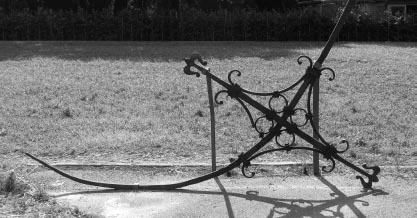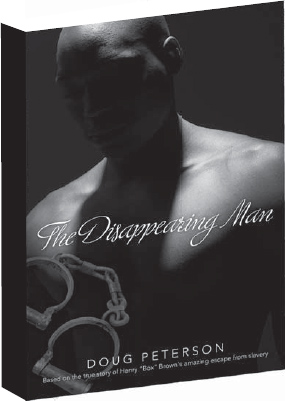Puzzle People (9781613280126) (29 page)
Read Puzzle People (9781613280126) Online
Authors: Doug Peterson
Tags: #The Puzzle People: A Berlin Mystery

The Puzzle People Today
Today, shredded Stasi documents are being reconstructed by computer, using the e-Puzzler software, developed by Berlin’s Fraunhofer Institute of Production Facilities and Construction Technology. The technology analyzes paper for thickness, color, typeface, and the outline of fragment edges; then it matches similar pieces together. The e-Puzzler can process ten thousand shreds of paper at a time.

This is the cross that was recovered from the Church of Reconciliation after the sanctuary was destroyed in 1985. When explosives brought the church down, the cross landed in a nearby cemetery and is now on display at the new Chapel of Reconciliation on Bernauer Strasse.
By my God, I can leap over a wall.
—Psalm 18:29
Author’s Notes
The Puzzle People
is fiction, and the characters are not based on any persons, deceased or living. However, many of the scenes in the novel are based on actual events.
I first learned about the puzzlers when I read Anna Funder’s amazing nonfiction book,
Stasiland.
She devotes a chapter to the people reassembling the shredded Stasi files in Zirndorf, just outside of Nuremburg. The office in Berlin where Annie and Kurt work never really existed. I created the Berlin office because I wanted to separate the goings-on in the fictional Berlin office from the real work that was taking place in Zirndorf. Also, I wanted most of the novel to take place in Berlin, with the exception of the scenes in Pullman City and Leipzig.
Each of the escapes is rooted in fact. A man actually escaped in an Austin-Healey Sprite by swerving around concrete barriers and barely slipping beneath a heavy boom before roaring into West Berlin at Checkpoint Charlie. I gave this escape method to Katarina, while Peter found himself unwittingly riding the Last Train to Freedom—an actual train escape led by Harry Deterling in December of 1961.
In addition, a group of students did work to bring people across the Berlin border, although they were known as the Girrmann Group, not the Kappel Group. They brought people across using forged passports until stricter measures by the border police made that much more difficult in January of 1962. The students also tapped into the sewers as an escape route, and I based the sewer escape in
The Puzzle People
on one that went haywire on October 12, 1961. The summer of ’62 was the most active period for tunneling, although tunnels had been dug from the very beginning. The tunnel escape that I portray—the one that opened up beneath a gravestone—is based on a graveyard tunnel that enabled many people to escape until it was discovered in December of 1961.
Many other events in the novel are based on real events as well. For instance, the Americans blasted rock-and-roll music over the Wall. They also broadcast news reports across the Wall, and I read of an incident in which the East Germans tried to drown out the news broadcasts with symphonic music. So I combined the two incidents and had the East Germans trying to drown out Brenda Lee with a Beethoven symphony.
One thing that often goes overlooked is the key role that churches played in the fall of communist governments throughout the Eastern Bloc. Many Americans are probably unaware that churches in Leipzig, particularly St. Nicholas, played pivotal roles in the fall of the GDR; that’s why the city was dubbed “Hero City.” The Monday prayer meetings at St. Nicholas began in the early 1980s, and they culminated in the Monday evening demonstrations that overwhelmed the communists in 1989. The October 9 scene depicted in the book is based on eyewitness accounts from the only book (in English) that I could find devoted to the church’s role in Leipzig—Wayne C. Bartee’s
A Time to Speak Out: The Leipzig Citizen Protests and the Fall of East Germany.
The final, climactic scene in the watchtower was inspired by my discovery that one of the few remaining watchtowers in Berlin is actually located just outside of an apartment complex. I had a chance to visit this watchtower, and I am grateful to have been allowed inside by Jürgen Litfin, the overseer. Herr Litfin preserved the watchtower in honor of his brother Günter, who was the first person shot while trying to cross into West Berlin after the border closed in 1961.
Some of the smaller scenes were also inspired by real events—such as the bride and groom being prevented from waving to their parents, or the family darting through the opening created in the barbed wire by West Berliners.
I have often been amazed that there has never been a major American movie based on the events of the rise or fall of the Berlin Wall—one of the most dramatic and important events of the twentieth century. However, there are two excellent German movies—
The Tunnel
and
The Lives of Others.
As you might guess from the title,
The Tunnel,
this move depicts a daring escape, while
The Lives of Others
(which won the 2006 Academy Award for Best Foreign Language Film) is about the Stasi’s invasions into everyday life. Both movies were valuable resources. I also relied on images from
Die Mauer
and
Stacheldraht,
two German documentaries produced during the first year after the Wall went up; and
Die Berliner Mauer 1989,
which includes photos taken of the entire stretch of the Berlin Wall just after the border opened in late 1989 but before the Wall was taken down.
Google Earth and YouTube also served as important tools in researching the rise and fall of the Berlin Wall, but I have to single out one video in particular; it features the iconic song by the Scorpions, “Winds of Change,” which was inspired by changes sweeping Eastern Europe in 1990. The video starts with text only, but it goes on to show some of the most moving images from 1961 and 1989. It depicts scenes of the Wall going up, families waving across the divide to loved ones, and people running for the Western border. It even includes a clip of Günter Schabowski, the communist bureaucrat who mistakenly announced that the border between East and West Berlin was going to open immediately on the night of November 9, 1989, inadvertently triggering the fall of the Wall. Whenever I needed a dose of inspiration, I would watch this video. You can find it at the following link:
http://www.youtube.com/watch?v=LdZVsFjWnbI&feature=related
If you want to see the border opening up on November 9, 1989, at Bornholmer Strasse (where I placed Stefan), check this link:
http://www.youtube.com/watch?v=1_eCVhCGYwE&playnext=1&list=PL2321C73AD446EA4B
Finally, if you want to get an idea of what the Stasi archives look like today, try this link:
http://www.youtube.com/watch?v=ha1jM9HAs6c
Karl May was wildly successful with his series of Western novels, even though he never visited America. But I decided against this approach and concluded that a visit to Berlin was warranted for
The Puzzle People.
I did so in August of 2011, visiting many of the locations in the novel.
In addition to
Stasiland
and
A Time to Speak Out,
other crucial books that I used for
The Puzzle People
include the following:
After the Wall,
by Jana Hensel, PublicAffairs (2004)
The Berlin Wall: A World Divided, 1961–1989,
by Frederick Taylor, Harper Perennial (2007)
The Berlin Wall,
by Pierre Galante, Doubleday and Company, Inc. (1965)
The Berlin Wall and the Intra-German Border 1961–1989,
by Gordon L. Rottman, Osprey Publishing (2008)
Escape to West Berlin,
by Maurine F. Dahlberg, Farrar, Straus and Giroux (2004)
Fashioning Socialism: Clothing, Politics and Consumer Culture in East Germany,
by Judd Stitziel, Berg (2005)
The File: A Personal History,
by Timothy Garton Ash, Vintage Books (1997)
The Ghosts of Berlin: Confronting German History in the Urban Landscape,
by Brian Ladd, University of Chicago Press (1997)
Jazz, Rock, and Rebels: Cold War Politics and American Culture in a Divided Germany,
by Uta G. Poiger, University of California Press (2000)
Stasi: The Untold Story of the East German Secret Police,
by John O. Koehler, Westview Press (1999)
The Wall Jumper: A Berlin Story,
by Peter Schneider, University of Chicago Press (1983)
The Year That Changed the World: The Untold Story Behind the Fall of the Berlin Wall,
by Michael Meyer, Scribner (2009)
Also From Doug Peterson…
The Disappearing Man
Based on the true story of a man who mailed himself to freedom A One Book, One Community selection in Canton, Ohio In development as a major motion picture
Sometimes, it’s better to think
inside
the box.
In 1849, with the help of two friends, a slave named Henry Brown was placed in a wooden box and shipped from Richmond to Philadelphia—a harrowing, 27-hour ordeal and one of the greatest escapes in American history. It was the ultimate disappearing act. Henry intended to make a man disappear in Richmond and miraculously reappear in Philadelphia. He aimed to turn a dead man into a living man, a slave into a free man.

Available from Bay Forest Books—the new world of cinematic fiction.

What others are saying about
The Disappearing Man
What a wonderfully inspiring story! Hie way the novel is written, I could see the scenes playing as if I was watching a film. It would make a terrific movie. This book is full of great historical details, and has moments that will choke you up, and others that will make you laugh out loud. One of the most unique and fascinating novels I’ve read in a long time.
Deborah Raney, Bestselling Novelist
Could the author, a man connected to VeggieTales, pull off a credible and gripping full-length novel, one set over 160 years ago and involving no animated characters? Hie answer: Absolutely! I got hooked on the storyline in the past—the abuses, the romance, the friendships—only to find myself hooked again on the harrowing portions dealing with Henry’s imprisonment in the box. Henry’s foes are set on finding him before he reaches freedom, and each successive chapter, like a sprinter’s pounding feet, propelled the plot toward its climax. It is more than just fast-paced entertainment; it is an eye-opening and educational reminder of the importance of grace, acceptance, and equality. Even as the lives of many slaves blew away like windswept leaves, those leaves spread seeds and life that continue on into today.
Eric Wilson, New York Times Bestselling Author
It is a story artfully and compassionately told, revealing the harsh realities of slavery as well as the courage of those who chose to risk everything for freedom.
Dr. Patricia Long, Chair, One Book One Community committee, Canton, Ohio
It’s a fascinating tale. I don’t have the influence that Oprah has with her book list, but I’ll say I recommend it highly. It’s one of the best reads I’ve had in quite some time.
Alan Jarand, RFD Radio Network
Doug Peterson’s
The Disappearing Man
is a wonderful addition to the historical fiction literary genre. There is just enough history to be vastly educational. There is just enough creativity to entertainingly fill in the blanks. There is more than enough of both to provide a good read. Teachers: This would be a beneficial addition to a school curriculum.
Dave Trouten, Division Chair, General Education, Kingswood University
Doug Peterson has rescued a compelling tale from the dusty attic of American history and brought it to the contemporary library of stories that warrant attention now. This is a story that blends the enduring power of romantic, committed love with a fundamental devotion to freedom. I heartily recommend this book!
Dr. William Sutton, History Teacher
He has done an excellent job of portraying slave life during the days of the Underground Railroad. I could feel Henry’s pain. This is an excellent read and a very good account of how Henry managed to escape by mail. Visit your local bookstore and pick up a copy.
Jo Ann Hakola, The Book Faerie
